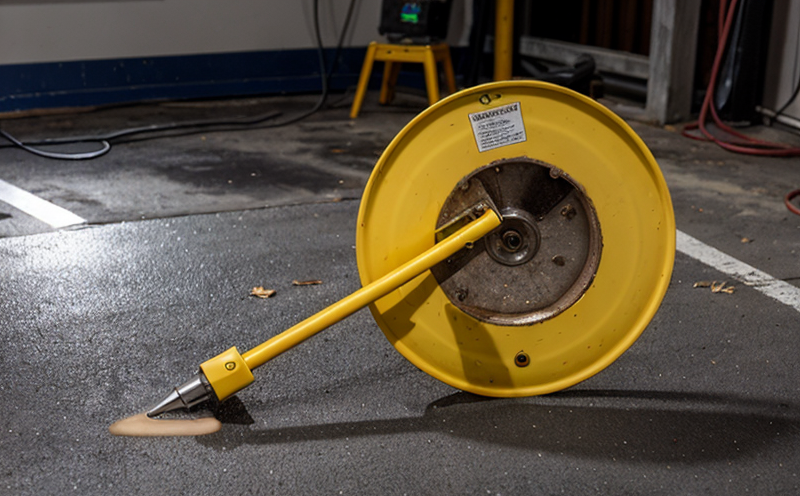ASTM E1444 Magnetic Particle Testing of Metallic AM Parts
The ASTM E1444 standard provides a robust framework for detecting surface and subsurface defects in metallic components produced through Additive Manufacturing (AM). This non-destructive evaluation technique is particularly valuable for ensuring the integrity of complex geometries often found in AM parts. The process involves magnetizing the part, applying magnetic particles to its surface, and then inspecting it for discontinuities or flaws that can compromise performance.
The ASTM E1444 standard applies specifically to metallic materials such as steels, iron alloys, and nickel-based alloys commonly used in AM processes. The testing method is designed to identify cracks, porosity, incomplete fusion, and other surface defects that may arise during the additive manufacturing process or subsequent heat treatment.
The test can be conducted using either a wet or dry magnetic particle inspection technique. Wet methods involve applying water-based suspensions of magnetic particles, while dry methods use fine particles mixed with talc powder. The choice between these techniques depends on factors such as the material type and the desired sensitivity level for defect detection.
Before conducting ASTM E1444 testing, proper preparation of the specimen is crucial. This includes cleaning the part to remove oil, grease, and other contaminants that could interfere with the magnetic field. The surface should also be free from excessive roughness or burrs, which can mask defects. In some cases, the test may require specific heat treatments like annealing to ensure a consistent magnetic response.
The test equipment used for ASTM E1444 typically includes a current source capable of generating a controlled magnetic field and a suitable magnetizing probe. The part is placed in a coil or other configuration designed to apply the magnetic field uniformly across its surface. Once magnetized, the component is carefully inspected using either an internal examination station or portable equipment for defects.
The standard specifies clear acceptance criteria for acceptable vs. unacceptable results. Acceptable parts will show no visible indications of discontinuities under specified inspection conditions. Unacceptable parts may exhibit non-relevant magnetic traces that do not indicate flaws, as well as relevant magnetic traces indicative of defects. The presence of these latter traces necessitates further investigation or rework.
ASTM E1444 testing is widely used across various industries where AM technology plays a critical role in manufacturing complex components with high-performance requirements. This includes aerospace, automotive, medical devices, and defense sectors. In the aerospace industry, for example, ensuring the integrity of turbine blades or engine parts is paramount to prevent catastrophic failures.
The use of ASTM E1444 testing aligns closely with international standards such as ISO 9712, which provides a general framework for non-destructive testing methods. By adhering to these standards, manufacturers can ensure consistent and reliable quality control processes that meet global regulatory requirements.
Why Choose This Test
The ASTM E1444 Magnetic Particle Testing of Metallic AM Parts offers several advantages over other non-destructive evaluation techniques. Firstly, it is highly sensitive to defects on both the surface and near-surface regions of metallic parts. This sensitivity makes it ideal for detecting small cracks or incomplete fusion that might otherwise go unnoticed using less precise methods.
Another key advantage is its ability to provide real-time feedback during production. By integrating ASTM E1444 testing into the manufacturing process, manufacturers can identify and address defects immediately after they occur. This proactive approach helps reduce waste and improve overall product quality.
- Cost Efficiency: Early detection of defects through ASTM E1444 reduces the need for extensive post-manufacturing inspections or rework.
- Improved Reliability: By ensuring that only defect-free parts proceed to subsequent stages, manufacturers can enhance the reliability and safety of their products.
- Regulatory Compliance: Adhering to ASTM E1444 helps ensure compliance with international standards, thereby simplifying market access in global markets.
The test also offers flexibility in terms of application. It can be adapted to various sizes and shapes of parts, making it suitable for a wide range of industrial applications. Additionally, the technique is non-destructive, meaning that it does not alter or damage the part being tested, preserving its usability for further inspection or use.
International Acceptance and Recognition
The ASTM E1444 standard enjoys widespread international recognition and acceptance across numerous industries. Its rigorous testing procedures and clear acceptance criteria have earned it a reputation for reliability and accuracy in defect detection. Many regulatory bodies around the world accept results from ASTM E1444 testing, including organizations like the European Union Aviation Safety Agency (EASA) and Federal Aviation Administration (FAA).
In aerospace applications, where part integrity is of utmost importance, ASTM E1444 has been endorsed by major certification authorities. Its use in this sector ensures that parts meet stringent safety standards and can be trusted for critical operations.
The standard's acceptance extends beyond the aerospace industry to other high-reliability sectors such as automotive manufacturing and medical device production. In these fields, ensuring that components are free from defects is essential for maintaining product quality and consumer trust.
Moreover, ASTM E1444 testing supports international harmonization efforts aimed at reducing barriers to trade. By aligning with globally recognized standards like this one, manufacturers can more easily export their products without undergoing additional local inspections or certifications.





